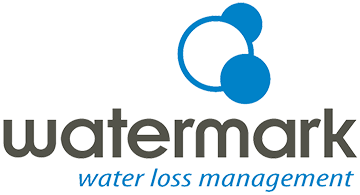System wide water leak detection and resource loss mitigation services.
Acoustic Leak Detection Surveys
Leak detection is a systematic search for water leaks within a distribution system. While many leaks are detected when utility or citizens observe water coming to the surface, an effective leakage program uses skilled technicians and sensitive equipment to identify leak sounds, in order to pinpoint the precise locations of underground leaks.
A proven method for leak detection involves the use of an electronic acoustical amplifier and a trained operator. The noise produced by pressurized water forcing its way through a crack or joint makes a distinct sound when on pipes, valves or services are “listened” to. Watermark Solutions Limited uses an enhanced, layered approach and methodology of surveying the water distribution system. This methodology has been tested and is proven to have a high success rate when compared to traditional methods. Potential leak sites can be identified by this method and further localized by Correlation Testing.
Leak Noise Correlation Testing
Watermark Solutions Ltd use modern digital computer-based leak noise correlators that have a simple field setup and work by measuring leak signals (sound or vibration) at two points that bracket the suspected leak. Accelerometer sensors are attached magnetically to a valve, hydrant or pipe on either side of the suspected leak location. The characteristics of the pipeline are entered into the correlators base unit and the position of the leak is then determined electronically, calculated using the time delay between the leak noise signals.
District Metered Area (DMA)
The first stage is to obtain hard data and identify realistic levels of real losses within the water distribution system. The most effective way of doing this is to isolate the system into smaller districts, and monitor flow trends in these districts. Typically each district will have the district flow monitored for a period of 7 days. During the course of this exercise, Watermark Solutions Ltd. carefully monitors any pressure fluctuations using data loggers, spread throughout the respective districts. The client will have full contact with the Watermark project manager via mobile telephone at all times. Usually most valves to be closed are of a smaller diameter, to ensure continued supply, and to alleviate abnormal supply conditions throughout the test period. Any major users, or critical customers such as dialysis patients, are carefully considered prior to any testing of this nature.
The District Meter Area (DMA) method of leak detection is primarily a flow-based technique, to quantify the level of leakage, or real water losses, in a water distribution system. It is effectively a way to prioritize between the areas of high and low leakage, so efforts can be focused in a more cost effective manner. Further investigation, to find the leaks, is only completed in the DMA’s with high leakage, once the temporary flow monitoring is complete.
Efficiency
The key to an overall water loss management system is balance, in terms of the reduction in physical losses as well as end user efficiency. When the focus of your program is to lower your per capita consumption, a strong leak detection program is equally important as the implementation and management of end user conservation programs.
Watermark has undertaken several water efficiency projects, including:
- Water audits, identifying areas of inefficiency within a building, plant or facility;
- Municipal water balances, where a proven data collection and analysis process outlines areas of concern, and quantifies the volume of water loss;
- Conservation program efficacy, through historical data analysis and comparison with empirical data collection;
- Retrofit program validation: comparing pre and post retrofit water usage.
Your individual requirements need individual solutions. Watermark and its network of professionals, technicians and consultants can assist you with any of the above, or customize a program to suit your needs.
Helium Tracer Gas Leak Detection – Hydrostatic Test Failure
Until recently, there were three basic methods of finding leakage on water mains that failed the hydrostatic test. The first technique is a visual examination of the ground surface for wet spots or surfacing water. The next procedure is usually excavating and exposing every joint and fitting. The last procedure is leak detection by electro-acoustic listening. The first two methods are self-explanatory. The third option makes use of traditional leak detection methods using standard listening equipment, based on the theory that a fluid leaking from a conduit generates a sound and therefore can be detected acoustically. All acoustic equipment, from the most primitive (listening on a valve with ones ear on the key) to the most sophisticated (the leak noise correlator), depend on this theory. However, the small leaks that normally occur causing a hydrostatic test failures, or normal leak found on PVC pipe, sometimes do not generate sufficient leak noise, which therefore can not be detected using traditional means.
Watermark Solutions Ltd. uses a more “cost” effective method for detecting these small leaks, called the Tracer Gas Injection Method. No excavation is required for the Tracer Gas testing, since the same feed and blow-off points as the original hydrostatic test can generally be used. In some cases, the Tracer Gas Injection Method becomes the only alternative effective approach and solution to locate leaks from a hydrostatic test failure.
This generally involves a Hydrostatic test in order to determine that the water main, joint connections and fittings have been installed properly, and will not leak under normal or adverse conditions. If the main does not pass the test, the contractor must find and repair any leaks on the system until the test is passed. Until recently, there were three basic methods of finding leakage on water mains that failed the hydrostatic test.
